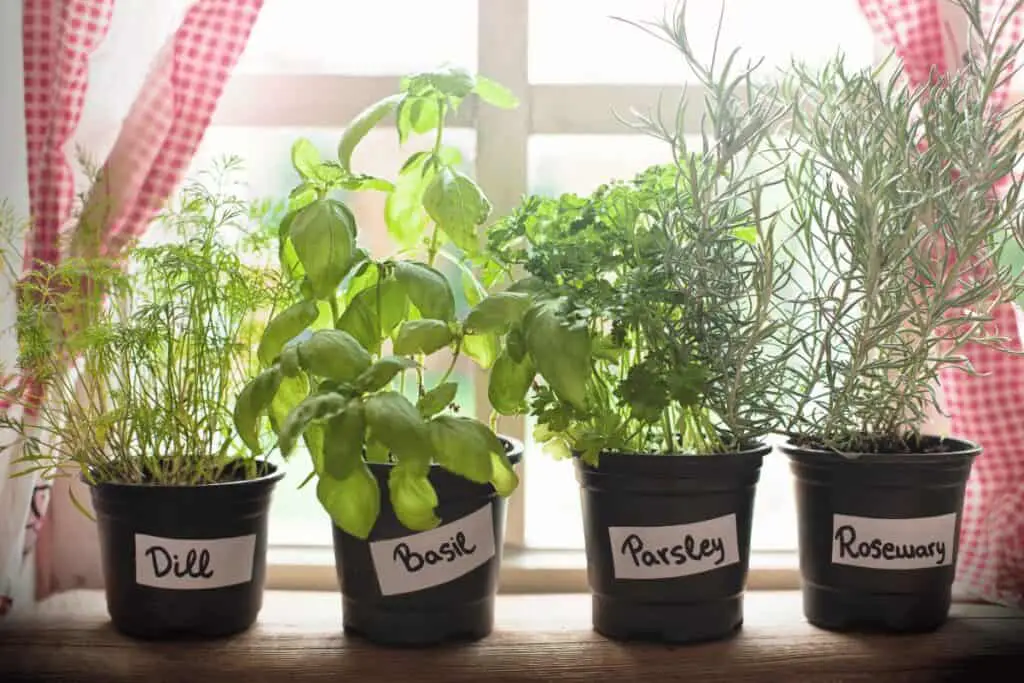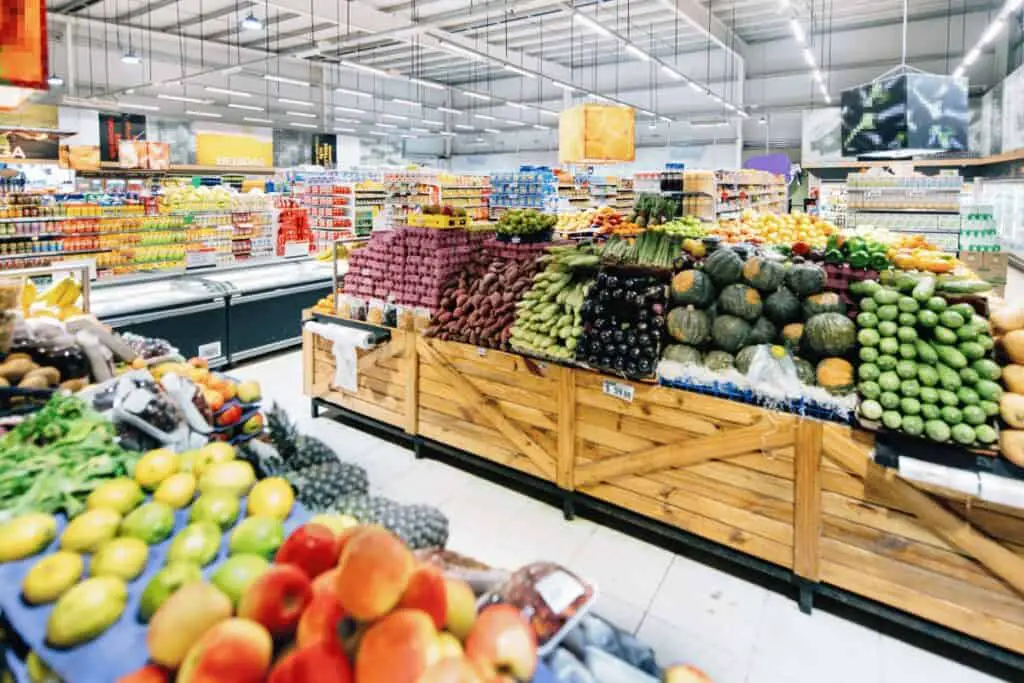Are you tired of seeing your supermarket herbs die within a few days of bringing them home? Read on to learn why this happens and how to keep your supermarket herbs alive and thriving.
Herbs are an essential part of cooking and add a delightful aroma and taste to dishes. However, buying fresh herbs from the supermarket can be disappointing, as they tend to wilt and die quickly. This can be frustrating, especially if you don’t have a garden or don’t have the time to grow your own herbs.
In this article, we’ll explore why supermarket herbs die and provide you with tips on how to keep them alive and thriving. We’ve gathered insights from three reputable sources [1, 2, and 3], so you can be confident in the advice we’re giving.
Why Do Supermarket Herb Plants Die?
Overcrowding Supermarket Herbs

Potted supermarket herbs are usually overcrowded in their containers, which means that they can quickly run out of room and nutrients [2]. When you buy herbs from the store, they may look healthy at first, but this can be deceptive.
Once the plants start to mature, they’ll quickly run out of space and nutrients, causing them to wilt and die.
Lack of Nutrients in Supermarket Herbs
Supermarket herbs are often grown in small pots that are filled densely with a lot of plants, resulting in a thick display of leaves for your cooking. However, this also means that the plants can quickly run out of nutrients and die [3].
When you bring the herbs home, they may already be depleted of nutrients, making it challenging for them to thrive.
Poor Drainage with Supermarket Herbs
Herbs need well-draining soil to prevent waterlogging, which can lead to root rot and eventually kill the plant. Unfortunately, many supermarket herbs come in containers with poor drainage, causing the soil to become waterlogged [1].
This can cause the roots to rot, preventing the plant from absorbing the necessary nutrients and water.
Inadequate Light for Supermarket Herb Plants
Herbs need plenty of sunlight to photosynthesize and produce the energy they need to thrive. However, many supermarket herbs are grown indoors and may not receive adequate sunlight. When you bring these herbs home, it’s important to ensure that they receive enough light to stay healthy [1].
Lack of Airflow for Supermarket Herb Plants
Airflow is essential for herbs to grow, as it helps to prevent fungal growth and disease. Unfortunately, many supermarket herbs are kept in plastic containers, which restrict airflow and create a humid environment that encourages fungal growth. To keep your herbs healthy, remove them from their plastic containers and place them in a pot with good drainage [1].
Poor soil quality Supermarket Herb Plants

Many supermarket herb plants are grown in low-quality soil that lacks the nutrients necessary for healthy growth. [1]Under pruning – Supermarket herb plants are often not pruned enough, leading to overcrowding and competition for resources. [3]
Poor soil quality refers to the condition of the soil that makes it less productive or unsuitable for growing plants. Soil degradation is a major cause of poor soil quality, resulting from natural or human-induced factors such as erosion, compaction, loss of organic matter, salinization, and pollution [1].
Poor soil quality affects plant growth and development, as the soil may lack essential nutrients, have an unfavorable pH level, or a poor soil structure, which makes it difficult for plant roots to absorb water and nutrients. Soil quality is essential for maintaining healthy ecosystems and ensuring food security, as it affects crop productivity and plant health [2].
Soil quality can be evaluated based on different factors, including texture, nutrient content, pH, and structure. Soil texture refers to the size of soil particles, which can affect soil water-holding capacity and nutrient availability [3]. The nutrient content is also important, as plants require essential elements such as nitrogen, phosphorus, and potassium to grow and produce healthy crops.
A soil test can help identify nutrient deficiencies and guide the application of fertilizers or other amendments to improve soil quality.
Overall, poor soil quality can have negative impacts on agriculture and the environment, but it can be improved through sustainable soil management practices such as soil conservation, crop rotation, cover cropping, and organic farming methods. By maintaining and improving soil quality, we can support healthy ecosystems and ensure food security for future generations.
Poor Initial Plant Selection of Supermarket Herbs
Starting with healthy plants is key to keeping supermarket herbs alive. Choose plants that are free from blemishes and have vibrant green leaves. Poor initial plant selection can result in a number of issues that can impact the health and success of the plant.
According to an article from Michigan State University, plant selection should be an organized process that considers the function or purpose of the plant [1]. If the purpose of the plant is not carefully considered, it can result in issues such as overcrowding, competition for resources, and disease.
In addition, soil type and quality should also be considered during plant selection. A soil test can provide important information on the type of soil, pH, and levels of important nutrients such as phosphorous and potassium [2]. Poor soil quality can lead to stunted growth, nutrient deficiencies, and increased susceptibility to disease.
Another factor to consider is plant genetics. In crops that are cross-pollinated, such as vegetables, mass selection can result in lower-quality plants if inferior plants are not removed from the field before pollination occurs [3].
Overall, poor initial plant selection can lead to a range of issues that can impact the health and success of the plant. It is important to carefully consider the function and purpose of the plant, soil quality, and genetics during the selection process.
Under Pruning – Supermarket Herb Plants
Under-pruning or over-pruning of plants can lead to various problems, including stunted growth, reduced yields, and damage to the plant’s overall health. Here are some details on the under-pruning of supermarket herb plants:
Supermarket herb plants are often sold in small pots and can become root-bound, which hinders their growth and can cause the plant to die off. Dividing these plants can help promote healthy growth and allow you to propagate more plants for free [1].
When it comes to pruning supermarket herb plants, it’s important not to under-prune them. Pruning is necessary to keep the plant healthy and encourage new growth.
Pruning also helps to prevent the plant from becoming too leggy and encourages a more compact growth habit. Prune your herb plants regularly by snipping off the stems about 3 to 4 inches down from the tops, just above a leaf node [3].
Pruning every couple of weeks will keep the plant tidy, prevent flowering, and encourage the growth of new leaves [3].
Under-pruning of supermarket herb plants can lead to reduced yields and cause the plant to become weak and spindly. If you notice that your herb plants are not producing as much as they should, it could be a sign that they need pruning to promote new growth and improve their overall health [2].
FAQS
How do you keep supermarket herb plants alive?
Supermarket herb plants often die quickly due to overcrowding and being root-bound, where the roots outgrow the pot they’re in and start to circle around trying to find more space, water, and nutrients [1]. To keep them alive, consider repotting them into larger pots with fresh soil and providing them with adequate drainage and watering. Additionally, ensure they receive proper sunlight or lighting and use organic fertilizer or foliar spray every few months [3].
Why do supermarket herbs die?
Supermarket herbs often die due to overcrowding and being root-bound in their pots, leading to a lack of space, nutrients, and water. They may also be exposed to changes in the environment, such as temperature and light when moved from the store to a different location. Supermarket herb plants are typically grown in optimal conditions for quick growth and sale, but these conditions may not be suitable for long-term survival [2].
How do you keep a supermarket basil plant alive?
To keep a supermarket basil plant alive, it’s recommended to repot it into a larger pot with fresh soil and ensure it receives proper sunlight or lighting. Water it regularly, but avoid overwatering or letting it sit in standing water. Use organic fertilizer or foliar spray every few months to provide it with the necessary nutrients [3].
How long do supermarket herbs last?
Supermarket herbs may only last for a few weeks to a few months, depending on their initial condition and care. However, with proper care, they can last much longer [1].
How do you regrow store-bought herbs?
Some store-bought herbs can be regrown by using cuttings or replanting their roots in the soil. For example, basil can be propagated from cuttings by removing the lower leaves and placing the stem in water until roots form, then transplanting into soil. Other herbs, such as mint and oregano, can be regrown by transplanting the entire plant, including its roots, into the soil [3].
Can I plant supermarket potted herbs?
Yes, supermarket potted herbs can be planted, but they may require repotting into larger containers with fresh soil and proper care to thrive long-term [1].
How do you repot supermarket herbs?
To re-pot supermarket herbs, gently remove them from their current pot and loosen any tangled roots. Place them in a new, larger pot with fresh soil and ensure it has adequate drainage. Water the plant thoroughly and provide it with proper sunlight or lighting [1].
How do you keep herbs alive indoors in the winter?
To keep herbs alive indoors in the winter, ensure they receive adequate sunlight or artificial lighting, as well as proper watering and drainage.
Conclusion
Based on the provided search results, it can be concluded that keeping supermarket herbs alive requires immediate attention upon purchase. Supermarket herbs are typically grown quickly and are meant to be used quickly as well, so they won’t survive for long in the pot they came in [2].
These herbs are almost always root bound and are struggling to survive in a pot that’s too small. To keep them alive, it is recommended to transplant them into garden beds or better garden planters [1].
However, this cannot be done immediately as the soil in which they are grown is often poor and they may have been overwatered or not pruned well enough by the supermarket [1]. Therefore, it is important to check the soil condition when bringing the herbs home.
To best preserve herbs, rinsing, drying, and trimming the stems are recommended, followed by storing them in a vase in the refrigerator [3]. However, it is important to note that this method is more applicable to herbs such as basil and not to all types of herbs.
In conclusion, to keep supermarket herbs alive, it is necessary to transplant them into larger pots or garden beds, pay attention to their soil condition, and provide them with appropriate care. Additionally, storing herbs in a vase in the refrigerator may help preserve them but is not a universal solution for all types of herbs.




